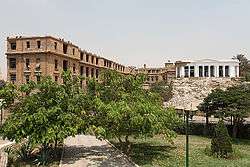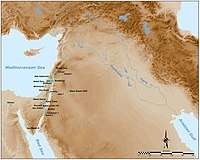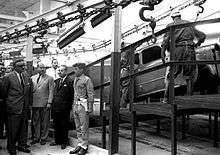Helwan
Helwan (Arabic: حلوان Ḥelwān, IPA: [ħelˈwæːn], Coptic: ϩⲁⲗⲟⲩⲁⲛ, romanized: Halouan[1]) is a city in Egypt and part of Greater Cairo, on the bank of the Nile, opposite the ruins of Memphis. Originally a southern suburb of Cairo, it served as the capital of the now defunct Helwan Governorate from April 2008 to April 2011, after which it was re-incorporated into the Cairo Governorate. The kism of Helwan had a population of 643,327 in the 2006 census.[2]
Helwan حلوان ϩⲁⲗⲟⲩⲁⲛ | |
|---|---|
 Farouk's palace | |
 Helwan Location in Egypt | |
| Coordinates: 29°51′N 31°20′E | |
| Country | |
| Governorate | Cairo |
| Area | |
| • Total | 25 sq mi (65 km2) |
| Population (2006) | |
| • Total | 643,327 |
| Time zone | UTC+2 (EST) |
History
The Helwan and Isnian cultures of the late Epipalaeolithic, and their Ouchata retouch methods for creating microlithic tools may have contributed to the development of the Harifian cultural assemblage of the Sinai, which may have introduced Proto-Semitic languages into the Middle East. Around 3000 to 2600 BC, there was a cemetery near Helwan serving the city of Memphis.
The city of Helwan was founded in 689 CE as Fustat's temporary replacement as the capital of Umayyad Egypt by its governor Abd al-Aziz ibn Marwan, who died in the new city.[3]
The Khedivial Astronomical Observatory was built here 1903–1904, and was used to observe Halley's comet. Egypt's oldest and largest private psychiatric clinic, the Behman Hospital, was constructed here in 1939.
During the early part of the 20th century, the city was the site of RAF Helwan, a major British airfield, which was later used by the Egyptian Air Force.
In 1959 Helwan was chosen to serve as a site of a major industrial city, as part of President Gamal Abdel Nasser's attempts to industrialize Egypt. Throughout the 1960s, it developed into a massive steelworks zone, with numerous automobile factories being built. The site continues to use electricity from the Aswan Dam and iron ore from Egypt's western deserts. Helwan was gradually transformed into a mass suburb of Cairo for the working class.[4]
In April 2008, the Helwan Governorate was split from the Cairo Governorate. It encompassed most of the suburbs, new compounds and villages located in the southern part of Cairo. The city of Helwan became the capital of the new governorate. Following the dissolution of the Helwan Governorate in April 2011, the city of Helwan was reincorporated into the Cairo Governorate.
.jpg) Helwan points (Abu Salem points sub-type)
Helwan points (Abu Salem points sub-type) Map of the Levantine sites with Helwan points
Map of the Levantine sites with Helwan points
Ecclesiastical history
Alphocranon was important enough in the Late Roman province of Arcadia Aegypti to be a suffragan of its Metropolitan Archbishop of Oxyrhynchus.
Its bishop, Harpocration, participated in the First Council of Nicaea in 325. The bishopric is mentioned in two Notitiae Episcopatuum.[5][6]
Titular see
No longer a residential diocese, Alphocranon is today listed by the Catholic Church as a Latin Catholic titular bishopric,[7] nominally restoring the diocese since 1933, but no incumbent is recorded.
Administrative divisions
The now defunct Helwan Governorate encompassed the following cities or districts: Maadi, Helwan, 15th of May, El Shorouk, New Cairo, Madinaty.
The city of Helwan itself includes districts such as Wadi Hof, Hadayek Helwan, and Maasara.
Economy

Local industry includes iron, steel, textiles and cement. The area has hot sulphur springs, an astronomical observatory, the Helwan University and a burial chamber (discovered in 1946). It is the terminus of Cairo's light rail Metro Line 1. Also trams in Helwan serve the people.
Climate
Köppen-Geiger climate classification system classifies its climate as hot desert (BWh). Owing to its proximity to Cairo, its average monthly temperatures are quite similar, but it has a quite different distribution of humidity and its diurnal average temperature variation is slightly larger.
| Climate data for Helwan | |||||||||||||
|---|---|---|---|---|---|---|---|---|---|---|---|---|---|
| Month | Jan | Feb | Mar | Apr | May | Jun | Jul | Aug | Sep | Oct | Nov | Dec | Year |
| Record high °C (°F) | 30.4 (86.7) |
33.2 (91.8) |
37.2 (99.0) |
42.4 (108.3) |
46.6 (115.9) |
46.7 (116.1) |
44.1 (111.4) |
43.8 (110.8) |
44.0 (111.2) |
40.2 (104.4) |
35.9 (96.6) |
29.8 (85.6) |
46.7 (116.1) |
| Average high °C (°F) | 18.5 (65.3) |
20.4 (68.7) |
23.4 (74.1) |
28.5 (83.3) |
32.2 (90.0) |
34.3 (93.7) |
35.0 (95.0) |
34.6 (94.3) |
32.6 (90.7) |
29.3 (84.7) |
24.5 (76.1) |
19.5 (67.1) |
27.7 (81.9) |
| Daily mean °C (°F) | 13.0 (55.4) |
14.5 (58.1) |
16.9 (62.4) |
21.4 (70.5) |
24.7 (76.5) |
27.3 (81.1) |
27.7 (81.9) |
27.6 (81.7) |
25.8 (78.4) |
23.3 (73.9) |
18.8 (65.8) |
14.4 (57.9) |
21.3 (70.3) |
| Average low °C (°F) | 7.9 (46.2) |
8.9 (48.0) |
10.9 (51.6) |
14.3 (57.7) |
17.3 (63.1) |
20.0 (68.0) |
20.9 (69.6) |
21.1 (70.0) |
19.8 (67.6) |
17.6 (63.7) |
13.7 (56.7) |
9.8 (49.6) |
15.2 (59.4) |
| Record low °C (°F) | −3.4 (25.9) |
2.2 (36.0) |
1.2 (34.2) |
6.6 (43.9) |
10.6 (51.1) |
14.8 (58.6) |
15.0 (59.0) |
11.2 (52.2) |
14.4 (57.9) |
10.8 (51.4) |
3.7 (38.7) |
2.8 (37.0) |
−3.4 (25.9) |
| Average precipitation mm (inches) | 5 (0.2) |
3 (0.1) |
2 (0.1) |
1 (0.0) |
0 (0) |
0 (0) |
0 (0) |
0 (0) |
0 (0) |
0 (0) |
2 (0.1) |
5 (0.2) |
18 (0.7) |
| Average precipitation days (≥ 1.0 mm) | 1.0 | 0.3 | 0.3 | 0.2 | 0.0 | 0.0 | 0.0 | 0.0 | 0.0 | 0.0 | 0.2 | 0.5 | 2.5 |
| Average relative humidity (%) | 62 | 57 | 54 | 43 | 41 | 45 | 52 | 56 | 56 | 55 | 58 | 61 | 53 |
| Mean monthly sunshine hours | 220.8 | 211.7 | 266.3 | 275.8 | 314.6 | 357.5 | 350.2 | 337.8 | 282.7 | 289.6 | 244.1 | 197.1 | 3,348.2 |
| Source: NOAA[8] | |||||||||||||
Notability
- Sadd el-Kafara, one of the earliest prehistoric man-made dams in the world.
- Harold Knox-Shaw, one of the earliest astronomy specialists in Helwan Observatory.
- John Reynolds, one of the earliest astronomy specialists in Helwan Observatory & president of the English Royal Astronomical Society between 1935 and 1937.
- Operation Priha: Helwan was targeted in Priha-1.
- Tewfik Pasha died in his palace at Helwan.
- The 6th Armoured Division (South Africa) was present at Helwan during WW II.
- The 82-BM-37 is known as "Helwan M-69 82mm mortar".
- Abdul Rahman Hassan Azzam Pasha lived in Helwan.
- Moataz Eno was born in Helwan.
- Cars produced at Helwan:
- Nasr 128
- Sahin 1.4S
- Sahin 1.6SL
- Zastava Florida In
- Fiat 1100
- Fiat 1300/1500
- Fiat 2300
- Polski Fiat 125p/FSO 125p
- FSO Polonez MR'83/MR'85
- FSO Polonez MR'86/MR'87/MR'89
- Fiat Ritmo
- Fiat Regata
- Fiat Tempra
- The English Middle East Command Camouflage Directorate was present in Helwan.
- Geoffrey Barkas designed the Operation Bertram while heading Middle East Command Camouflage Directorate.
- RAF Helwan was a British airbase.
- No. 112 Squadron RAF was stationed at Helwan.
- A crater on the 951 Gaspra asteroid was named after the spa city of Helwan.
- Inebu-hedj
See also
- List of ancient Egyptian sites, including sites of temples
- 15th of May
- Greater Cairo
- Helwan retouch
- Helwan University
- Maadi
References
- Emile, Amélineau (1893). La géographie de l’Egypte à l'époque copte. Paris: Imprimerie nationale. p. 584.
- Central Agency for Public Mobilisation and Statistics, Population and Housing Census 2006, Population distribution by sex, gov: Cairo Archived 2008-12-11 at the Wayback Machine Retrieved on 2008-04-01.
- Kennedy, Hugh (1998). "Egypt as a Province in the Islamic Caliphate, 641–868". In Petry, Carl F. (ed.). Cambridge History of Egypt, Volume One: Islamic Egypt, 640–1517. Cambridge: Cambridge University Press. p. 71. ISBN 0-521-47137-0.
- Beattie, Andrew. (2005) Cairo: A Cultural and Literary History. Signal Books. p. 196. ISBN 9781902669779
- Siméon Vailhé, v. Alphocranon, in Dictionnaire d'Histoire et de Géographie ecclésiastiques, vol. XII, Paris 1953, col. 677
- Klaas A. Worp, A Checklist of Bishops in Byzantine Egypt (A.D. 325 - c. 750), in Zeitschrift für Papyrologie und Epigraphik 100 (1994) 283-318
- Annuario Pontificio 2013 (Libreria Editrice Vaticana 2013 ISBN 978-88-209-9070-1), p. 829
- "Helwan Climate Normals 1961–1990". National Oceanic and Atmospheric Administration. Retrieved June 25, 2015.
External links
| Wikimedia Commons has media related to Helwan. |
- (in German) Helwan on Wikivoyage
- GCatholic